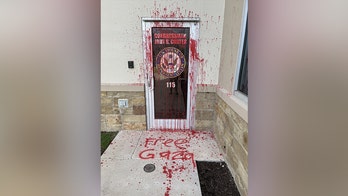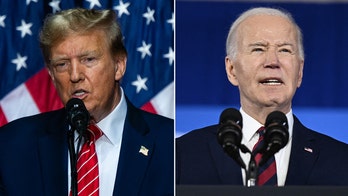Voting reform bill is at a temporary stand-still
Fox News congressional correspondent Chad Pergram has the latest on HR 1 on 'Special Report'
Democrats may have reached the periphery of their power in Washington already.
That’s despite controlling the House, Senate and White House.
This phenomenon was best on display Tuesday evening when Democrats didn’t summon a single Republican to vote to trigger debate on a voting rights bill.
This was not a straight, up/down vote on the measure. It was just procedural to begin debate on the legislation. The measure needs 60 yeas to launch debate. It was expected to fail, and did. That stymied even consideration of the measure on the floor.
The vote revealed the limits of the Democratic majority in a split Senate. And, it played it to the letter.
Fifty Democrats voted to start debate. Fifty Republicans opposed, effectively filibustering the legislation.
But that’s well short of what Democrats needed.
And that was that.
PROGRESSIVES FUME AFTER REPUBLICANS USE FILIBUSTER TO BLOCK DEMS' S.1 ELECTION REFORM BILL
By mid-afternoon Tuesday, Senate Majority Leader Chuck Schumer, D-N.Y., rushed to the microphones in the Ohio Clock Corridor just outside the Senate chamber with a breaking announcement.
Schumer had negotiated with Sen. Joe Manchin, D-W.Va., about the bill. Manchin developed his own voting rights plan. But Manchin had agreed to vote yes to proceed to the voting rights legislation.

Senate Majority Leader Chuck Schumer, D-N.Y., meets with reporters before a key test vote on the For the People Act, a sweeping bill that would overhaul the election system and voting rights, at the Capitol in Washington, Tuesday, June 22, 2021. (AP Photo/J. Scott Applewhite) (AP Photo/J. Scott Applewhite)
News alerts instantly lit up the phones of reporters and Democratic activists all over Washington. Manchin would allow the voting bill to come to the floor.
But Schumer’s wrangling of Manchin’s vote wasn’t exactly a breakthrough at Yalta.
It didn’t change anything.
Manchin had taken lot of heat from the left about not being a team player. He wasn’t supporting the Democratic agenda. In fact, the day after the vote, the Poor People’s Campaign staged a rally on Capitol Hill titled the "Moral March on Manchin and McConnell."
Still, Manchin had gotten to work and developed a compromise plan which Schumer embraced. It was even blessed by Stacey Abrams. In fact, part of Schumer’s pact with McConnell was that if the Senate ever cleared the procedural hurdle to begin debate on the bill, Schumer would strip out the base text of the original plan and substitute it with Manchin’s proposal. In other words, this was Manchin’s bill.
But, it was never going to get that far under present circumstances since Democrats couldn’t vault the Republican filibuster.
Naturally, Democrats want to weaponize this roll call vote against Republicans. With the GOP’s unanimous opposition blockading debate on the bill, Democrats can deploy that vote as a wedge in the 2022 midterms. Democrats hope to show their voters that Republicans stopped voting rights reform. Democrats will then encourage their base to get to the polls based on the outcome on this issue.
Manchin also got a lot of what he wanted. He developed a compromise. But, for a bill which went nowhere. So maybe Manchin didn’t lose much skin in the process. Manchin reaps the benefits of looking like a team player and not an obstructionist. Plus, Schumer keeps his caucus together and delivered all 50 members as yeas on the procedural vote.
Still, another internecine battle brews as liberal House Democrats are increasingly turning up the heat on President Biden for not getting the voting bill done.
"He’s not absent," said Rep. Jamaal Bowman, D-N.Y., of the president’s efforts on voting rights. "But he needs to be a lot more vocal and a lot more out front." White House spokeswoman Jen Psaki defended the president when asked about Bowman’s criticism.
"Those words are a fight against the wrong opponent," said Psaki.
In other words, Manchin’s vote and compromise inoculates the president from internal criticism from his left flank. Schumer and company delivered all 50 Democratic votes. There’s not much more the president can do unless someone can cajole 10 Republicans to come around.
And, there’s a reason why the president deployed Vice President Kamala Harris to the Senate dais. From there, Harris would preside over debate on the motion to proceed to the bill and subsequent failed vote. The choreography sent a message to the left that the administration is doing all it can on voting rights.
Harris voted to break two ties earlier in the day to help confirm Kiran Ahuja as the Director of the Office of Personnel Management. But Harris was barred from casting a tie-breaking vote on the motion to proceed to the voting bill since 60 votes were necessary to crush the filibuster.
"The president and I are very clear. We support S.1," said Harris during a gaggle with reporters just off the floor following the vote. "The fight is not over."
Sen. Jeff Merkley, D-Ore., described Tuesday’s vote as "round one" for the voting bill. But when pressed by reporters about what was "round two," Schumer really didn’t offer a path forward. Schumer offered boilerplate about having more discussions and not "putting the cart before the horse."
This brings us back to one key: the future of the filibuster.
If all 50 Democrats can stick together, they could lower the threshold for changing the filibuster – with a tie-breaking vote by Vice President Harris. But Manchin opposes that. Sen. Kyrsten Sinema, D-Ariz., made it clear she doesn’t want to kill the filibuster, penning an op-ed in the Washington Post.
So Tuesday’s vote didn’t advance the voting bill. But it did return the Senate to the debate about the future of the filibuster. Groups working to alter the filibuster are now ramping up their efforts.
"There’s a lot of members who support the (voting) bill, who have supported the filibuster over the years who now realize that it’s being abused," said Eli Zupnick, a former aide to Sen. Patty Murray, D-Wash. Zupnick says those members "are now more open than ever to reform."
CLICK HERE TO GET THE FOX NEWS APP
Changing filibuster provisions likely requires the "nuclear option." That’s where one party unilaterally changes filibuster provisions, lowering the bar to end a given filibuster. Democrats ignited the first nuclear option in 2013. They dropped the threshold to overcoming a filibuster from 60 to 51 for most executive branch nominees with the initial nuclear option. Senate Republicans followed suit with a nuclear option of their own for Supreme Court nominees in 2017.
The only thing which remains is the 60 vote threshold to impede legislation.
Democrats lack the votes for a nuclear strike on the filibuster just yet. But Tuesday’s vote awarded them something they needed in their arsenal to alter the filibuster: a failed procedural vote. A failed procedural vote is what Democrats and Republicans both used when they nuked parts of the filibuster in 2013 and 2017. And the failed cloture vote Tuesday awards Democrats the parliamentary fissile material for nuclear strike on the filibuster of their own.






